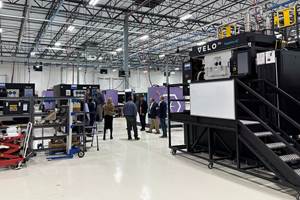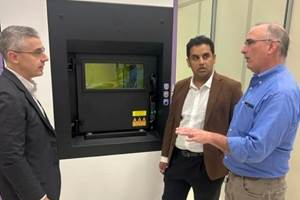Nexa3D Dental Resins, Workflow Increase Throughput
Nexa3D’s growing dental resin portfolio now includes 10 validated materials for both the NXD series and the XiP printer platforms.
Polymer 3D printing provider Nexa3D continues to expand its digital dentistry portfolio with the release of two more dental resins as well as a new dental workflow. The two new resins join a portfolio of eight validated dental resins, bringing the total number to 10, and further breaking dental 3D printing productivity barriers by increasing production throughput by as much as 50%, the company says.
It is said the xDENT201 resin is the fastest printing modeling resin designed for ultrafast production of orthodontic models, yielding up to 10 flat models in just 20 minutes. Showcasing excellent accuracy yield at over 93% at 100 micron deviation, coupled with great dimensional stability, xDENT201 is an optimal choice for printing higher volume models for aligner manufacturing or orthodontic modeling needs. This matte gray resin also provides excellent visibility and fine feature details at an economical price, making it a well suited for scaled additive production of dental models.
Nexa3D’s xDENT341 resin is a high-resolution material designed for 3D printing removable die models with incredible accuracy and dimensional stability. A new level of precision with 93% dimensional accuracy at 50-micron deviation places the material well above the standard dental industry accuracy rate of 65%. Proper fit is paramount for removable die models and xDENT341 exhibits precise margins and contacts, delivering highly accurate custom prosthodontic treatments, such as crowns, bridges and other implants at incredible speed.
Both resins further push the production limits of dental 3D printing by reducing production time by as much as 38% and dramatically increasing the throughput on both the XiP desktop 3D printer as well as the NXD 200Pro platform.
“We think dental 3D printing applications warrant — and quite frankly deserve — a higher level of throughput and more favorable production economics. This is exactly why our material development team, along with our material partners, continue to push the limits of what is possible when it comes to both print speed and dimensional accuracy of 3D printed models,” says Avi Reichental, Nexa3D co-founder and CEO. “We couldn’t be more excited to bring these two new dental resins to market because we believe they will have a dramatic impact on the productivity of dental labs as well as deliver better patient outcomes.”
The NexaX Dental Workflow is Nexa3D’s new software module aimed at maximizing productivity for dental laboratories, starting with orthodontic and removable die applications. The new dental workflow enables users to spend less time prepping and more time printing. The new features include streamlined and automated file import, orientation and toolset selection for file repair, plane cutting and base extrusion. Additionally, the NexaX Dental Workflow optimizes model nesting across multiple builds, enabling the creation of an entire day's worth of print jobs through an intuitive and easy-to-use platform.
- Learn more about the Nexa3D XiP Pro industrial 3D printer which is designed for fast, quality production. The company says the XiP Pro delivers the highest daily throughput at the lowest operational costs for the production of industrial and medical device components, enabling onshoring and reshoring efforts with additive manufacturing.
- Read about Nexa3D’s expanding resin portfolio with ceramic, flexible, clear materials. Nexa3D worked with material experts at BASF and Henkel to validate custom formulations for its ultrafast fleet of industrial and desktop 3D printers.
Related Content
Zeda AM Production Plant in Ohio Now Open — Thoughts on the New Facility
73,000-square-foot metal powder bed fusion plant includes extensive machining capability plus separate operational models for serving medical versus other businesses.
Read MoreDurable, Waterproof 3D Printed Casts: The Cool Parts Show #58
Recovering from an injury with an ActivArmor cast means that patients can exercise, bathe and live life while they heal. We get a firsthand look at the solution in this episode of The Cool Parts Show.
Read MoreNew Zeda Additive Manufacturing Factory in Ohio Will Serve Medical, Military and Aerospace Production
Site providing laser powder bed fusion as well as machining and other postprocessing will open in late 2023, and will employ over 100. Chief technology officer Greg Morris sees economic and personnel advantages of serving different markets from a single AM facility.
Read MoreFDA-Approved Spine Implant Made with PEEK: The Cool Parts Show #63
Curiteva now manufactures these cervical spine implants using an unusual 3D printing method: fused strand deposition. Learn how the process works and why it’s a good pairing with PEEK in this episode of The Cool Parts Show.
Read MoreRead Next
3D Printed Polymer EOAT Increases Safety of Cobots
Contract manufacturer Anubis 3D applies polymer 3D printing processes to manufacture cobot tooling that is lightweight, smooth and safer for human interaction.
Read MoreBike Manufacturer Uses Additive Manufacturing to Create Lighter, More Complex, Customized Parts
Titanium bike frame manufacturer Hanglun Technology mixes precision casting with 3D printing to create bikes that offer increased speed and reduced turbulence during long-distance rides, offering a smoother, faster and more efficient cycling experience.
Read MoreAlquist 3D Looks Toward a Carbon-Sequestering Future with 3D Printed Infrastructure
The Colorado startup aims to reduce the carbon footprint of new buildings, homes and city infrastructure with robotic 3D printing and a specialized geopolymer material.
Read More





















